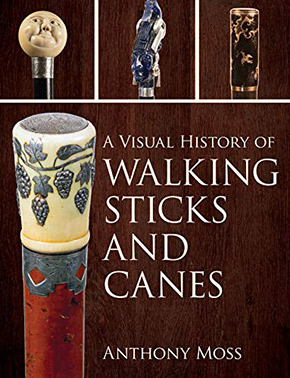Rare and exotic walking sticks first came to our attention during a visit to New Orleans several years ago when we met with Bill Rau of M.S. Rau antiques on Royal Street. It was there that we learned about the fascinating history of walking sticks and canes and that they were much more than an accessory for the fashionable as they negotiated cobblestone streets. We also learned that there was much more to them than what met the eye.
It was at M.S. Rau that we learned that some walking sticks and canes had specially built secret compartments, and of course once we heard that we were immediately intrigued and wanted to learn more. For example, a medical cane could have a hidden compartment inside that would hold specially designed medical tools, a billiards player’s cane could hold a cue stick, a fisherman could have a pole inside the compartment, etc. However, in some cases, the canes and walking sticks had a more nefarious purpose and had specially built interior compartments that could hold liquid and could be sprayed on unsuspecting victims.
On a more recent visit to The Peekskill Museum, we were enchanted to discover that among their collection of walking sticks and canes, they had a cane that had a small hidden compartment that could hold a tiny rolled-up note and was perhaps used as a "spy tool."
After our introduction in New Orleans, and visiting The Peekskill Museum, we were delighted when we recently discovered A Virtual History of Walking Sticks and Canes by Anthony Moss, published by Rowman & Littlefield, an imprint of The Rowman & Littlefield Publishing Group, Inc. Anthony Moss’s book goes into great depth about their history and includes interesting information on the various types of walking sticks and canes such as medical canes, musical canes, architects’ canes, watch canes, and many more, that were designed to hold tools of the individual’s trade.
Of particular interest to us was a writing set cane which concealed a watch under the decorative cover, with an interior compartment that included "a mirror, two glass ink bottles with gilt metal lids, a penknife, a gift metal pen, a cylindrical metal-container with leads and a seal stick with a perpetual calendar, and a candle and vesta containing match strikes" (page 129 of A Virtual History of Walking Sticks and Canes by Anthony Moss). If you love gadgets, you will be fascinated by Anthony’s collection.
The book consists of 8 chapters that take the reader on a journey from the origin of walking sticks and canes throughout the ages and how they are once again popular. As fans of the television show, Hotel Portofino, we love how the character Cecil Ainsworth played by the actor Mark Umbers uses his walking stick as a jaunty sidekick as well as uses it whenever he wants to make a point and uses the walking stick to push up the brim of his hat. What a fabulous accessory! If you see Luxury Experience sporting walking sticks as fashionable accessories, we can "blame it" on Anthony Moss’s book.
For information on Author Anthony Moss, please visit his website: Anthony Moss
Websites where you can purchase A Virtual History of Walking Sticks and Canes by Anthony Moss: Where to Buy in the UK and North America, Amazon, Barnes & Noble and others.
A Virtual History of Walking Sticks and Canes by Anthony Moss
Published by Rowman & Littlefield
An imprint of The Rowman & Littlefield Publishing Group, Inc.
© 2021 by the Rowman & Littlefield Publishing Group, Inc.
All images © Anthony Moss
4501 Forbes Boulevard, Suite 220,
Latham, Maryland 20706
United States
Telephone: 1-800-462-6420
6 Tinworth Street
London SE11 5AL
United Kingdom
Website: www.rowman.com
Cover Images courtesy of the author
ISBN: 978-1-5381-4495-4 (hardcover): $75.00
ISBN: 978-1-5381-4496 (e-book)
Follow Luxury Experience on YouTube: @edwardnesta9910 @luxurypair
Follow Luxury Experience on Facebook: www.facebook.com/LuxuryExperience
Follow Luxury Experience on Twitter: www.twitter.com/luxurypair @luxurypair
© October 2023. Luxury Experience. www.LuxuryExperience.com All rights reserved.



